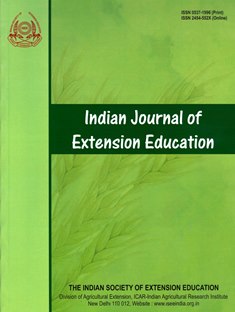Status and Changes in Composition of Agricultural Household’s Income in India
DOI:
https://doi.org/10.48165/IJEE.2023.59113%20Keywords:
Doubling farmers’ income, Income diversity, Simpson index of diversification, Situation assessment surveyAbstract
The study used the NSSO’s Situation Assessment Survey from 2012-13 and 2018-19 to determine the current status and changes in the composition of agricultural household income. During the agricultural years 2012-13 and 2018-19, an agricultural household’s total nominal farm income increased at an annual rate of 9.61 per cent, while real income increased at a rate of 3.42 per cent. Assuming the projected growth trends in nominal and real income continue, the nominal income of agricultural households will take 7.5 years to double at All India levels, while the real income will take 21 years. The income composition of an agricultural household changed throughout the same period. The average annual percentage change in income from wages and salaries (10.37%) and from animal sources (6.14%) grew positively throughout the period, whereas crop (-1.25%) and non-farm business (-0.94%) grew negatively. 12 per cent increase in the share of wages and salaries in overall income was discovered and a corresponding reduction in crop income. In the agricultural year 2018-19, Rajasthan had the largest diversity in income sources (SID=0.43), and Andhra Pradesh had the lowest (SID=0.25), while All India had (SID=0.35). The result indicates that agricultural households are shifting their dependency for livelihood from crop income towards wages and salaries.
Downloads
References
Agrawal, A., Chaudhary, U., & Raju, R. (2021). Estimation of potential economic benefits of livestock farming in rural Madhya Pradesh. Indian Journal of Extension Education, 57(4), 49–53.
Birthal, P. S., Negi, D. S. & Roy, D. (2017). Enhancing farmers’ income: who to target and how? ICAR-National Institute of Agricultural Economics and Policy Research, New Delhi, Policy paper no. 30, April (2017). doi: http://www.ncap.res.in/ upload_files/policy _paper/Policypaper30.pdf
Chand, R. (2017). Doubling farmers’ income: rationale, strategy, prospects and action plan. NITI Policy Paper No. 1/2017, March. http://www.niti.gov.in//writereaddata/files/Doubling%20 farmers%20income.pdf
Chandrasekhar, S., & Mehrotra, N., (2016). Doubling farmers’ incomes by 2022: What would it take? Economic & Political Weekly, 51, 10–11. http://www.epw.in
Government of India (2014). Situation assessment survey of agricultural households in NSS 70th round, Directorate of Economics and Statistics, Ministry of Agriculture and Farmers Welfare, Govt. of India, New Delhi. http://www.icssrdataservice.in
Government of India (2020). Report of the committee on ‘Doubling Farmers’ Income’. Ministry of Agriculture and Farmers Welfare, Govt. of India, New Delhi. https://agricoop.nic.in
Government of India (2021). NSS Report No. 587: Situation assessment of agricultural households and land and livestock
holdings of households in rural India, 2019, Directorate of Economics and Statistics, Ministry of Agriculture and Farmers Welfare, Govt. of India, New Delhi. http://www.icssrdataservice.in
Jadhav, R. (2022, May 15). Why doubling farmers’ income is still a dream. The Hindu Business Line. https://www. thehindubusinessline.com/data-stories/deep-dive/why-doubling farmers-income-is-still-a-dream/article65388168.ece
Lewis, Arthur W. (1972). ‘Reflections on unlimited labour.’ in: Luis Eugenio Di Marco, International Economics and Development: Essays in honour of Raul Prebisch, New York, Academic Press, pp. 75-96.
NAAS (2016). Strategy for transformation of Indian agriculture for doubling farm income and improving farmers’ welfare. National Academy of Agricultural Sciences, New Delhi, Strategy paper no. 3. http://naas.org.in
Narayanamoorthy, A., & Sujitha, K. S. (2021). Trends and determinants of farmer households’ income in India: A comprehensive analysis of SAS data. Indian Journal of Agricultural Economics, 71(3), 620-642.
Priscilla, L., Kar, P., Krishnadas, O., Nivetina, L., & Sharma, P. R. (2021). Economic Impact of Crop Diversification in North East India: Evidence from Household-level Survey. Indian Journal of Extension Education, 57(4), 104–109.
Roy, P., & Bhattacharyya, S. (2020). Doubling farmers’ income: Its necessity and possibilities in Indian context. The Indian Journal of Agricultural Sciences, 90(9), 1639–1645.
Saha, C., Acharya, S. K., Haque, M., Chatterjee, R., & Mandal, A. (2021). Attributes of farm income operating on conservation agriculture: The multivariate and ANN analytics. Indian Journal of Extension Education, 58(1), 44–48.
Satyasai, K. J. S. (2016). Farmers’ income: Trend and strategies for doubling. Indian Journal of Agricultural Economics, 71(3), 397-405.
Downloads
Published
Issue
Section
License

This work is licensed under a Creative Commons Attribution-NonCommercial-NoDerivatives 4.0 International License.

